Assignment On Congestive Heart Failure
VerifiedAdded on 2022/09/15
|5
|1082
|19
Assignment
AI Summary
Contribute Materials
Your contribution can guide someone’s learning journey. Share your
documents today.
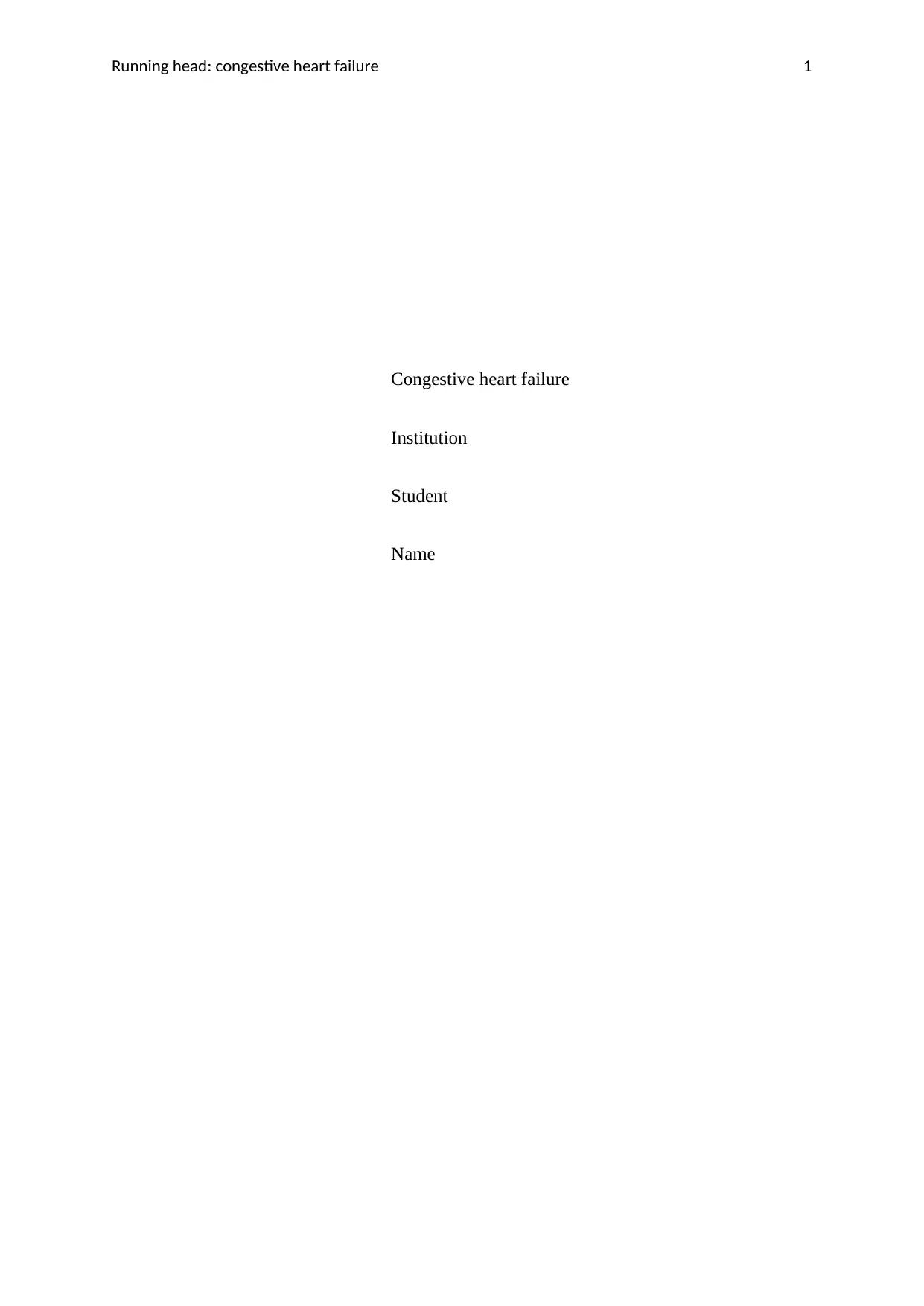
Running head: congestive heart failure 1
Congestive heart failure
Institution
Student
Name
Congestive heart failure
Institution
Student
Name
Secure Best Marks with AI Grader
Need help grading? Try our AI Grader for instant feedback on your assignments.
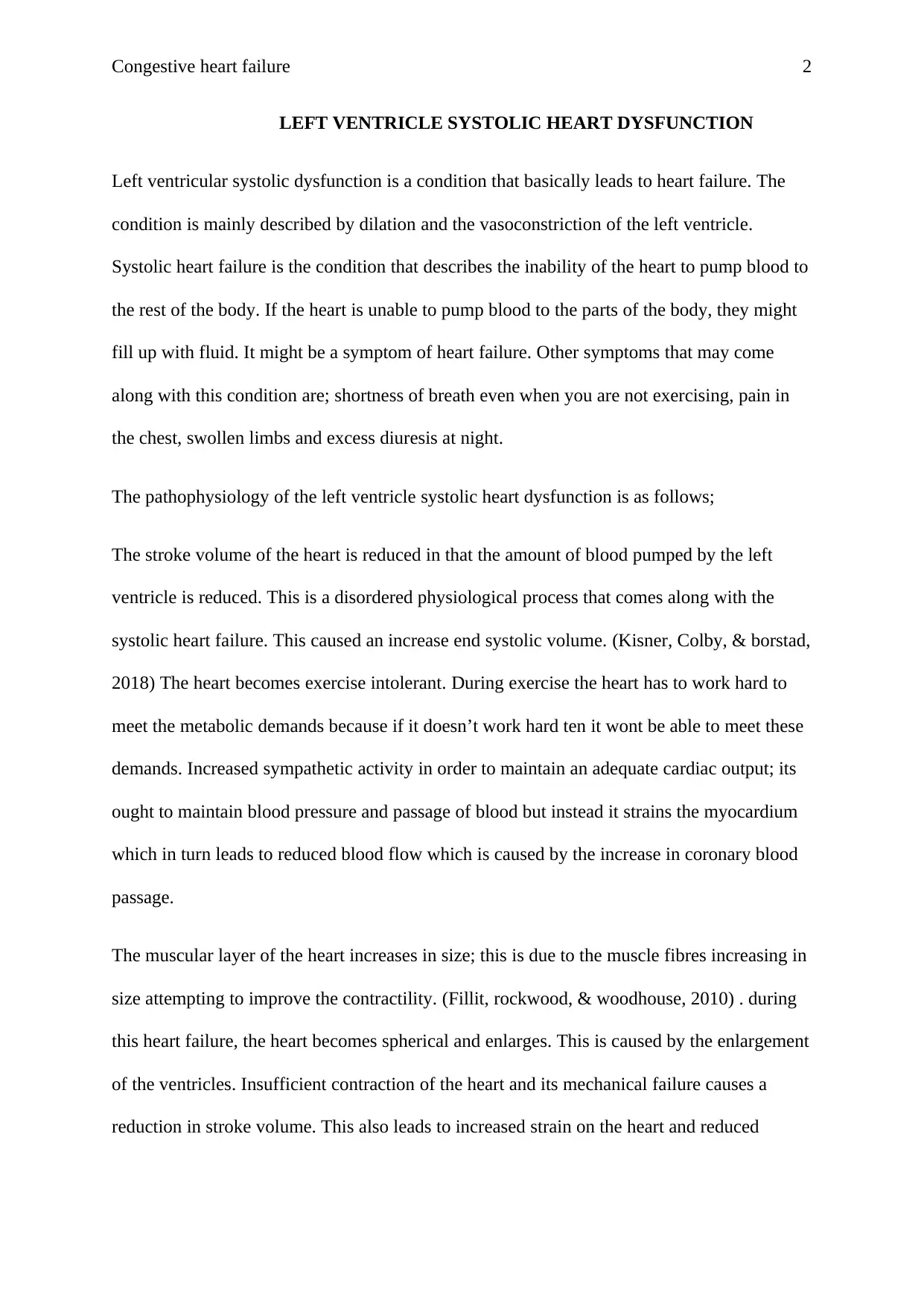
Congestive heart failure 2
LEFT VENTRICLE SYSTOLIC HEART DYSFUNCTION
Left ventricular systolic dysfunction is a condition that basically leads to heart failure. The
condition is mainly described by dilation and the vasoconstriction of the left ventricle.
Systolic heart failure is the condition that describes the inability of the heart to pump blood to
the rest of the body. If the heart is unable to pump blood to the parts of the body, they might
fill up with fluid. It might be a symptom of heart failure. Other symptoms that may come
along with this condition are; shortness of breath even when you are not exercising, pain in
the chest, swollen limbs and excess diuresis at night.
The pathophysiology of the left ventricle systolic heart dysfunction is as follows;
The stroke volume of the heart is reduced in that the amount of blood pumped by the left
ventricle is reduced. This is a disordered physiological process that comes along with the
systolic heart failure. This caused an increase end systolic volume. (Kisner, Colby, & borstad,
2018) The heart becomes exercise intolerant. During exercise the heart has to work hard to
meet the metabolic demands because if it doesn’t work hard ten it wont be able to meet these
demands. Increased sympathetic activity in order to maintain an adequate cardiac output; its
ought to maintain blood pressure and passage of blood but instead it strains the myocardium
which in turn leads to reduced blood flow which is caused by the increase in coronary blood
passage.
The muscular layer of the heart increases in size; this is due to the muscle fibres increasing in
size attempting to improve the contractility. (Fillit, rockwood, & woodhouse, 2010) . during
this heart failure, the heart becomes spherical and enlarges. This is caused by the enlargement
of the ventricles. Insufficient contraction of the heart and its mechanical failure causes a
reduction in stroke volume. This also leads to increased strain on the heart and reduced
LEFT VENTRICLE SYSTOLIC HEART DYSFUNCTION
Left ventricular systolic dysfunction is a condition that basically leads to heart failure. The
condition is mainly described by dilation and the vasoconstriction of the left ventricle.
Systolic heart failure is the condition that describes the inability of the heart to pump blood to
the rest of the body. If the heart is unable to pump blood to the parts of the body, they might
fill up with fluid. It might be a symptom of heart failure. Other symptoms that may come
along with this condition are; shortness of breath even when you are not exercising, pain in
the chest, swollen limbs and excess diuresis at night.
The pathophysiology of the left ventricle systolic heart dysfunction is as follows;
The stroke volume of the heart is reduced in that the amount of blood pumped by the left
ventricle is reduced. This is a disordered physiological process that comes along with the
systolic heart failure. This caused an increase end systolic volume. (Kisner, Colby, & borstad,
2018) The heart becomes exercise intolerant. During exercise the heart has to work hard to
meet the metabolic demands because if it doesn’t work hard ten it wont be able to meet these
demands. Increased sympathetic activity in order to maintain an adequate cardiac output; its
ought to maintain blood pressure and passage of blood but instead it strains the myocardium
which in turn leads to reduced blood flow which is caused by the increase in coronary blood
passage.
The muscular layer of the heart increases in size; this is due to the muscle fibres increasing in
size attempting to improve the contractility. (Fillit, rockwood, & woodhouse, 2010) . during
this heart failure, the heart becomes spherical and enlarges. This is caused by the enlargement
of the ventricles. Insufficient contraction of the heart and its mechanical failure causes a
reduction in stroke volume. This also leads to increased strain on the heart and reduced
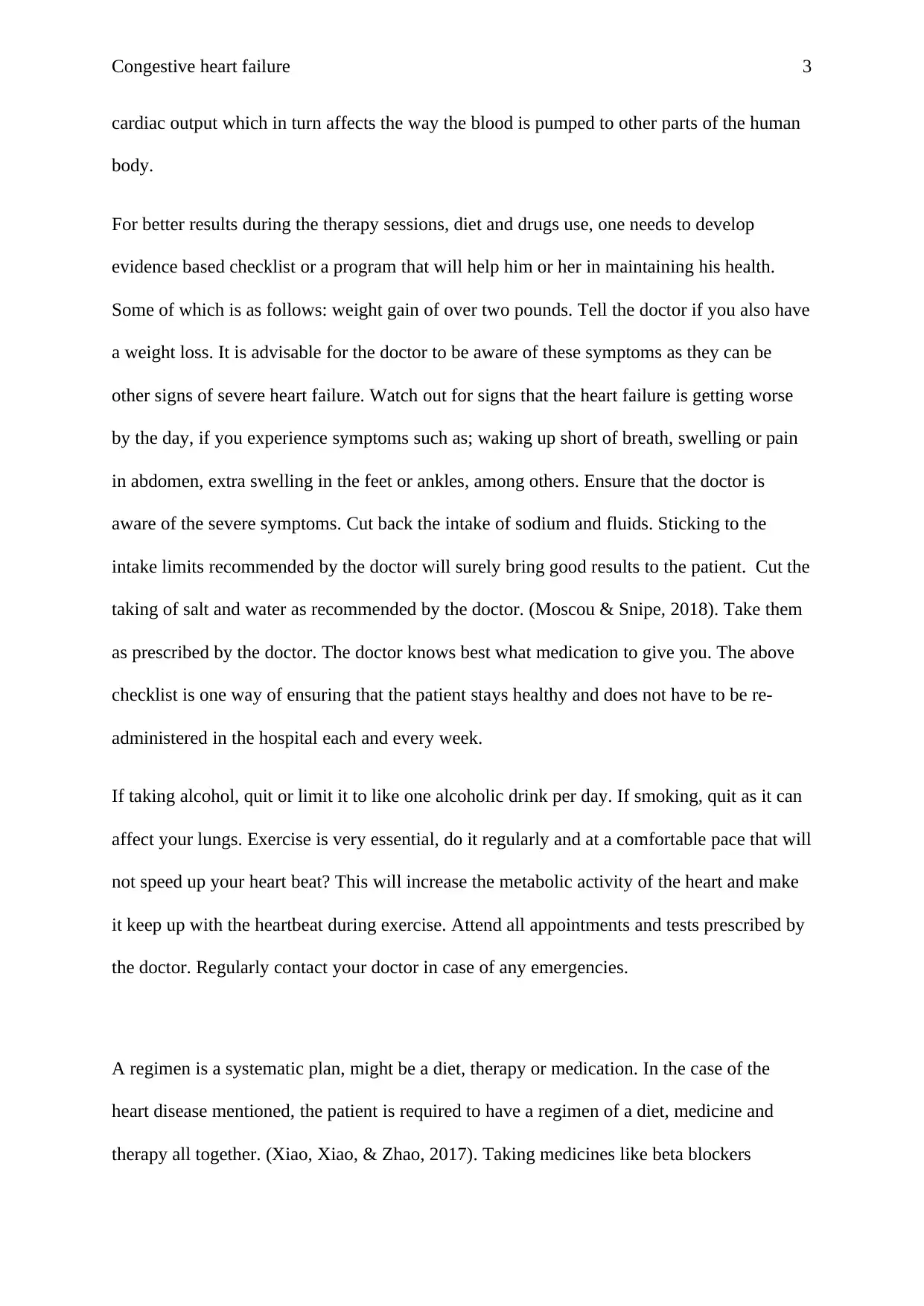
Congestive heart failure 3
cardiac output which in turn affects the way the blood is pumped to other parts of the human
body.
For better results during the therapy sessions, diet and drugs use, one needs to develop
evidence based checklist or a program that will help him or her in maintaining his health.
Some of which is as follows: weight gain of over two pounds. Tell the doctor if you also have
a weight loss. It is advisable for the doctor to be aware of these symptoms as they can be
other signs of severe heart failure. Watch out for signs that the heart failure is getting worse
by the day, if you experience symptoms such as; waking up short of breath, swelling or pain
in abdomen, extra swelling in the feet or ankles, among others. Ensure that the doctor is
aware of the severe symptoms. Cut back the intake of sodium and fluids. Sticking to the
intake limits recommended by the doctor will surely bring good results to the patient. Cut the
taking of salt and water as recommended by the doctor. (Moscou & Snipe, 2018). Take them
as prescribed by the doctor. The doctor knows best what medication to give you. The above
checklist is one way of ensuring that the patient stays healthy and does not have to be re-
administered in the hospital each and every week.
If taking alcohol, quit or limit it to like one alcoholic drink per day. If smoking, quit as it can
affect your lungs. Exercise is very essential, do it regularly and at a comfortable pace that will
not speed up your heart beat? This will increase the metabolic activity of the heart and make
it keep up with the heartbeat during exercise. Attend all appointments and tests prescribed by
the doctor. Regularly contact your doctor in case of any emergencies.
A regimen is a systematic plan, might be a diet, therapy or medication. In the case of the
heart disease mentioned, the patient is required to have a regimen of a diet, medicine and
therapy all together. (Xiao, Xiao, & Zhao, 2017). Taking medicines like beta blockers
cardiac output which in turn affects the way the blood is pumped to other parts of the human
body.
For better results during the therapy sessions, diet and drugs use, one needs to develop
evidence based checklist or a program that will help him or her in maintaining his health.
Some of which is as follows: weight gain of over two pounds. Tell the doctor if you also have
a weight loss. It is advisable for the doctor to be aware of these symptoms as they can be
other signs of severe heart failure. Watch out for signs that the heart failure is getting worse
by the day, if you experience symptoms such as; waking up short of breath, swelling or pain
in abdomen, extra swelling in the feet or ankles, among others. Ensure that the doctor is
aware of the severe symptoms. Cut back the intake of sodium and fluids. Sticking to the
intake limits recommended by the doctor will surely bring good results to the patient. Cut the
taking of salt and water as recommended by the doctor. (Moscou & Snipe, 2018). Take them
as prescribed by the doctor. The doctor knows best what medication to give you. The above
checklist is one way of ensuring that the patient stays healthy and does not have to be re-
administered in the hospital each and every week.
If taking alcohol, quit or limit it to like one alcoholic drink per day. If smoking, quit as it can
affect your lungs. Exercise is very essential, do it regularly and at a comfortable pace that will
not speed up your heart beat? This will increase the metabolic activity of the heart and make
it keep up with the heartbeat during exercise. Attend all appointments and tests prescribed by
the doctor. Regularly contact your doctor in case of any emergencies.
A regimen is a systematic plan, might be a diet, therapy or medication. In the case of the
heart disease mentioned, the patient is required to have a regimen of a diet, medicine and
therapy all together. (Xiao, Xiao, & Zhao, 2017). Taking medicines like beta blockers
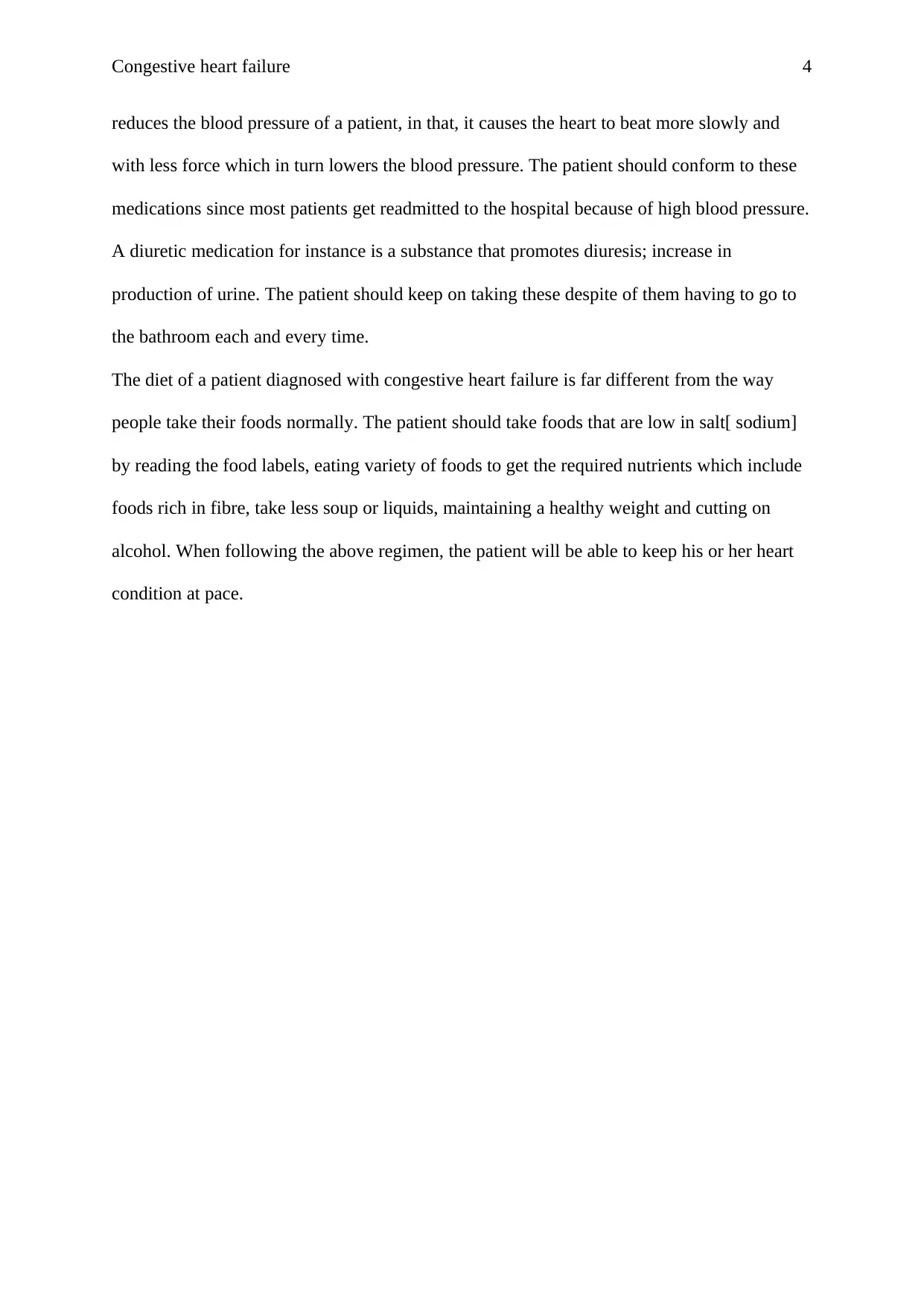
Congestive heart failure 4
reduces the blood pressure of a patient, in that, it causes the heart to beat more slowly and
with less force which in turn lowers the blood pressure. The patient should conform to these
medications since most patients get readmitted to the hospital because of high blood pressure.
A diuretic medication for instance is a substance that promotes diuresis; increase in
production of urine. The patient should keep on taking these despite of them having to go to
the bathroom each and every time.
The diet of a patient diagnosed with congestive heart failure is far different from the way
people take their foods normally. The patient should take foods that are low in salt[ sodium]
by reading the food labels, eating variety of foods to get the required nutrients which include
foods rich in fibre, take less soup or liquids, maintaining a healthy weight and cutting on
alcohol. When following the above regimen, the patient will be able to keep his or her heart
condition at pace.
reduces the blood pressure of a patient, in that, it causes the heart to beat more slowly and
with less force which in turn lowers the blood pressure. The patient should conform to these
medications since most patients get readmitted to the hospital because of high blood pressure.
A diuretic medication for instance is a substance that promotes diuresis; increase in
production of urine. The patient should keep on taking these despite of them having to go to
the bathroom each and every time.
The diet of a patient diagnosed with congestive heart failure is far different from the way
people take their foods normally. The patient should take foods that are low in salt[ sodium]
by reading the food labels, eating variety of foods to get the required nutrients which include
foods rich in fibre, take less soup or liquids, maintaining a healthy weight and cutting on
alcohol. When following the above regimen, the patient will be able to keep his or her heart
condition at pace.
Secure Best Marks with AI Grader
Need help grading? Try our AI Grader for instant feedback on your assignments.
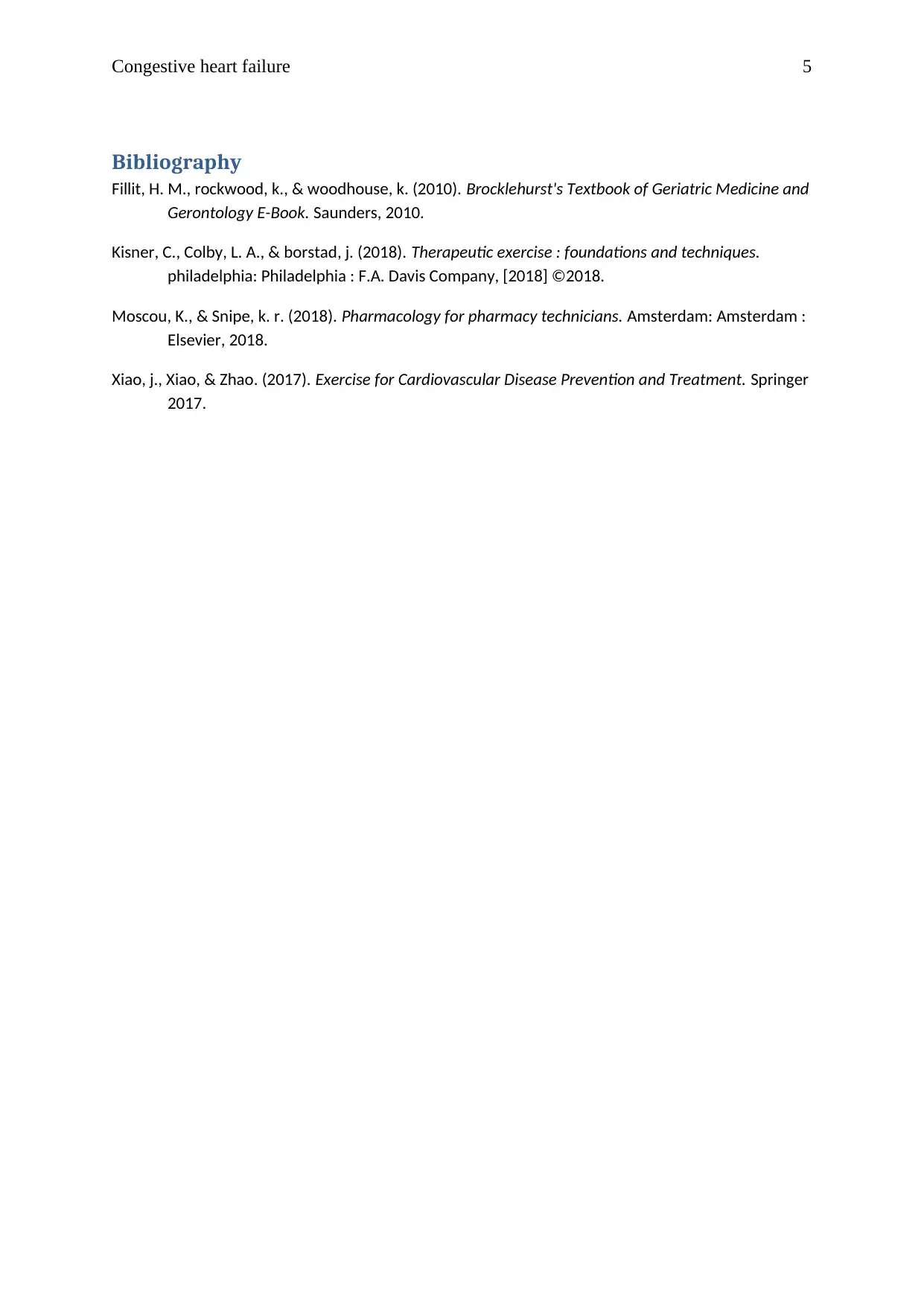
Congestive heart failure 5
Bibliography
Fillit, H. M., rockwood, k., & woodhouse, k. (2010). Brocklehurst's Textbook of Geriatric Medicine and
Gerontology E-Book. Saunders, 2010.
Kisner, C., Colby, L. A., & borstad, j. (2018). Therapeutic exercise : foundations and techniques.
philadelphia: Philadelphia : F.A. Davis Company, [2018] ©2018.
Moscou, K., & Snipe, k. r. (2018). Pharmacology for pharmacy technicians. Amsterdam: Amsterdam :
Elsevier, 2018.
Xiao, j., Xiao, & Zhao. (2017). Exercise for Cardiovascular Disease Prevention and Treatment. Springer
2017.
Bibliography
Fillit, H. M., rockwood, k., & woodhouse, k. (2010). Brocklehurst's Textbook of Geriatric Medicine and
Gerontology E-Book. Saunders, 2010.
Kisner, C., Colby, L. A., & borstad, j. (2018). Therapeutic exercise : foundations and techniques.
philadelphia: Philadelphia : F.A. Davis Company, [2018] ©2018.
Moscou, K., & Snipe, k. r. (2018). Pharmacology for pharmacy technicians. Amsterdam: Amsterdam :
Elsevier, 2018.
Xiao, j., Xiao, & Zhao. (2017). Exercise for Cardiovascular Disease Prevention and Treatment. Springer
2017.
1 out of 5
Related Documents
Your All-in-One AI-Powered Toolkit for Academic Success.
+13062052269
info@desklib.com
Available 24*7 on WhatsApp / Email
![[object Object]](/_next/static/media/star-bottom.7253800d.svg)
Unlock your academic potential
© 2024 | Zucol Services PVT LTD | All rights reserved.





